14
John Melvin VicaireJohn Melvin Vicaire
Served in World War I
He was really brave
And many medals he won.
He was doing really great,
In the war that he served,
But died on December 30th, 1915.
To this day,
His body still remains,
At the cemetery in France,
Where he and the other soldiers
Will be honoured because
Of their bravery.
Even though he died,
We will remember him forever,
In the war he fought
To protect his homeland.
By Desmond Jerome-Martin, Grade 7, New Richmond High School
15
John Vicaire - Dead Soldier's PennyWorld War I, 1914-1918
Gesgapegiag, Quebec
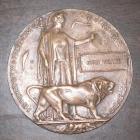 Credits:
Credits:Desmond Jerome-Martin, Grade 7, NRHS
Gordon Dell (History Teacher, NRHS)
16
These medals were awarded to Robert (Bob) Barter, a veteran of the Second World War, and a native of Cascapedia-St.Jules, Quebec. Brandon McWhirter brought them in as his treasure. Brandon interviewed Bob Barter, who is still alive, and did the following tribute to him.A story about a surviving Veteran
Mr. Robert "Bob" Barter joined the army July 1941 at the age of 18. He decided to join to help out his country. He was among 1,975 Canadians who has also joined, many of whom were, or became, his best of friends. He was in the army from July 1941 till December 1941. He trained for the army in Quebec City, Sussex N.B, St. John's N.B, and Botwood. In November 1941 he was transferred to Hong Kong. While in Hong Kong he became a physical fitness trainer on the island of Hong Kong, one day while he was doing his training they were all called and told that the battle for Hong Kong had broken out so we need to go now. He said that it was unreal how much people were running and did not know what or where to go. Very confusing time for everyone.
The battle actually broke out on December 8, 1941 and lasted till December 25, 1941, during this time there was a lot of shooting and blasting going on, He said he seen a lot of people die right in front of him. It was terrible. When the Battle of Hong Kong ended on December 25, 1941 at this time the Canadians were taken prisoners by the Japanese and were held prisoners of war until they were released in August 1945. That day being December 25, 1941 would be a Christmas no one would forget. It was a day that the battle ended but as we did not know that it would be the beginning of a nightmare for all of us.
While he was held prisoners in Japan he had to deal with death threats, routine beatings from the Japanese, and lack of nutritious food and very little medical attention. He had to sleep on a thin rubber material which was very cold and uncomfortable. In the mornings they had to roll it up each morning before he had to go and work like slaves from 12 -18 hours a day in the coal mines. He had to eat rice every day, every meal and most of the time the rice had bugs or maggots in it. He also ate rats and raw snakes.
Even though we all went through the worst part of our lives, I was lucky to have returned home but was hospitalized in Quebec City for a lung condition as I had the misfortune of sleeping beside a gentleman who died from tuberculosis ( TB) and was released a few months later when the results came back negative. After returning home I married the love of my life Bertha Coull and we married on July 15, 1946 and had 7 beautiful children. At the end of the war mostly all of the Hong Kong veterans received at least four medals but Bob Barter that I know of got 6 medals.
Now that Mr. Barter is 89 years old and he is glad to still be here to tell us youngsters as much as he can remember about World War II.
17
Robert Barter's MedalsWorld War II, 1939-1945
Cascapedia-St.Jules, Quebec, Canada
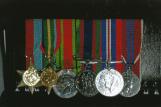 Credits:
Credits:Brandon McWhirter, Grade 5, NRHS
Gordon Dell (History Teacher, NRHS)
18
Zachary Cyr brought in a Salvation Army Christmas Card as his military treasure and shared the following story:Edgar Carroll
Edgar Carroll was from Cascapedia St-Jules. He served in Italy during the Second World War. Edgar was a Royal Canadian Electrical Mechanical Engineer. He survived the war. He was my grandmother's uncle. Unfortunately he died in 2004 at the age of 84.
The Christmas Card
This Christmas Card was provided by the Sally Ann Association which is the Salvation army. He sent it out in 1944 from Italy.
19
Salvation Army Wartime Cristmas Card - Interrior ViewWorld War II, 1939-1945
New Richmond High School, New Richmond, Quebec Canada
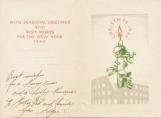 Credits:
Credits:Zachary Cyr, Grade 7, NRHS
Gordon Dell (History Teacher, NRHS)
20
Salvation Army Wartime Christmas CardWorld War II, 1939-1945
New Richmond High School, New Richmond, Quebec Canada
 Credits:
Credits:Zachary Cyr, Grade 7, NRHS
Gordon Dell (History Teacher, NRHS)
21
Scott Legouffe brought in a First World War Canadian Expeditionary Force Service Pay Book as his military treasure. The pay book belonged to Joseph Ethier who was born on March 15th 1892 and was drafted into service in 1917.22
Joseph Ethier's Canadian Expeditionary Force Soldier's Pay BookWorld War I, 1914-1918
New Richmond High School, New Richmond, Quebec Canada
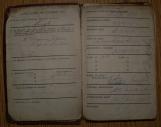 Credits:
Credits:Scott LeGouffe, Grade 5, NRHS
Gordon Dell (History Teacher, NRHS)
23
Nipuktuk Joseph's treasure was five bills from Italy and German dating to the Second World War.24
Nipuktuk Joseph's Treasure - Wartime Money (Italian and German)World War II, 1939-1945
Gesgapegiag, Quebec
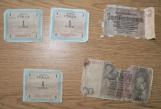 Credits:
Credits:Nipuktuk Joseph, Grade 6, NRHS
Gordon Dell (History Teacher, NRHS)
25
Selena McWhirter's military treasure is a napkin which was signed by a number of survivors shortly after their liberation from Japanese prisoner of war camps in 1945. Canada and its allies fought Japan during the Second World War. The Canadian forces were sent to defend Hong Kong against the Japanese. The Canadian soldiers in Hong Kong were forced to surrender Christmas Day 1941 and the survivors would spend the next 3 years, 8 months, 27 days as prisoners of war.26
Hong Kong POW HandkerchiefWorld War II, 1939-1945
New Richmond High School, New Richmond, Quebec Canada
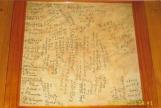 Credits:
Credits:Selena McWhirter, Grade 8, NRHS
Gordon Dell (History Teacher, NRHS)
27
Laura LeBlanc brought in a framed collage of memorabila which originally belonged to Otis Harrison as her military treasure. She wrote the following tribute:Otis Harrison
My artifacts are a beret, a harmonica, a letter that Otis Harrison wrote in Tokyo,Japan, matches, a sticker, a letter his mother wrote to him, some newspapers that gave information from the war, a picture of his team and a picture of him when he was 17 years old. We also have two of his badges.
The beret was a part of Otis' uniform. They used the harmonica in 1939 to make some music at their camps. The letters were used to keep the communication between the families. Back then, the newspapers were used to have more information on what was going on in the war. The matches are use to remember the end of the war and the sticker is use to represent the forty years of the end of war.
The beret was used in 1945. The harmonica was used in 1939. Otis wrote the letter in 1945 and the one that his mother wrote was written in 1946. In 1942 the newspapers were published.
The beret and harmonica belonged to Otis and he wrote the letter and sent it to his mom. The rest of the things, the letter Otis' mother wrote, the pictures, the newspapers, the matches and the stickers belonged to Gertude B. Harrison, his mother. When she died she gave the things to my grand-mother, Lorraine Harrison, and when she died, she gave the things she had to my mom, Ann LeBlanc. We think that Otis' mother never got the letter Otis wrote for her before he died. There are also other things that we don't have because it's in the other parts of the Harrison family.
Otis was born on the 26th of March 1922 and died on the 24th of February 1946 at the age of 23. He was the son of Maxwell and Gertude B. Harrison from Grand Cascapedia. He began in the war in 1939. He didn't have to go to war, he went there because his friends were going. When he went to war he was only 17 years old.
My treasure is important to me because Otis is part of our family. All these things bring back memories to our family members. It's also his history. We can also see how his handwriting was. The beret is also important because that's what he wore on his head.
He died unluckily. He died on the way back. He was talking to someone on a train, and when the train went off, it kind of kicked like it usually does, but he was on the side of the train and fell off the train, and died.
Laura.L.P